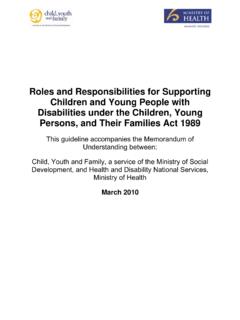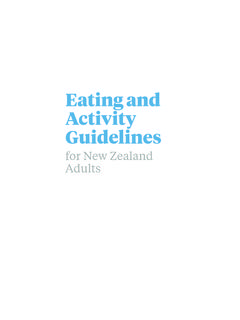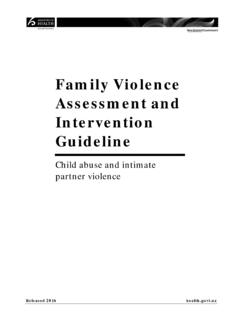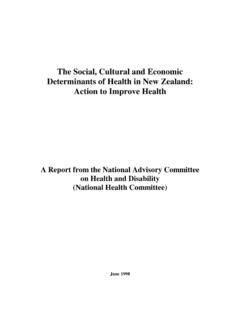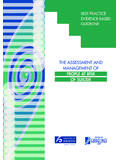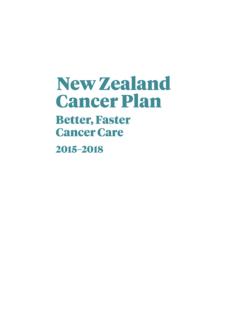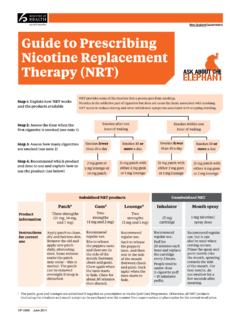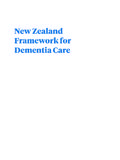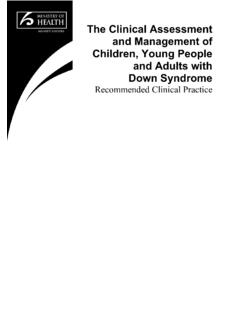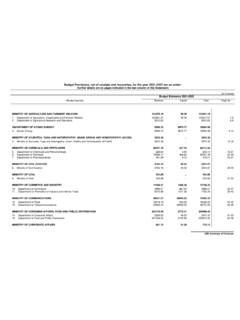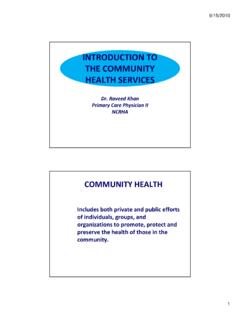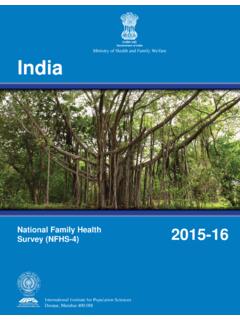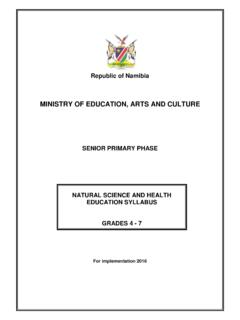Transcription of Sustainability and the health sector - Ministry of Health
1 Sustainability and the Health sector A guide to getting started 2019. Released 2019 Citation: Ministry of Health . 2019. Sustainability and the Health sector : A guide to getting started. Wellington: Ministry of Health . Published in July 2019 by the Ministry of Health PO Box 5013, Wellington 6140, New Zealand ISBN 978-1-98-856884-3 (online). HP 7123. This document is available at This work is licensed under the Creative Commons Attribution International licence. In essence, you are free to: share ie, copy and redistribute the material in any medium or format; adapt ie, remix, transform and build upon the material. You must give appropriate credit, provide a link to the licence and indicate if changes were made. Contents Introduction 1. Sustainability context 2. Sustainable development goals 2. Sustainability in Aotearoa 4. Benefits of Sustainability 5.
2 Ensuring success 6. Organisational commitment 6. Measuring progress 6. Equity and pro-equity actions 7. Raising awareness 8. Building networks 8. Actions for Sustainability 10. General actions 10. Transport 10. Procurement 12. Waste 13. Energy 14. Food 16. Building design 16. Case studies 18. Hawke's Bay District Health Board Go Well initiative 18. Victoria University LED lighting 19. Further reading 20. References 21. List of Figures Figure 1: Sustainable development goals and environment- Health risks 3. Figure 2: Te K hau o Te Ngira a mana whenua Sustainability framework 4. Figure 3: Co-benefits of Sustainability 5. Figure 4: Actions for ensuring successful Sustainability programmes 6. Figure 5: Northland DHB 2018 carbon emissions 7. Sustainability AND THE Health sector : A GUIDE TO GETTING STARTED iii List of Tables Table 1: Organisations and initiatives to consider for Sustainability networking 8.
3 Table 2: Actions to promote sustainable transport 11. Table 3: Actions to promote sustainable procurement 13. Table 4: Actions to promote Sustainability with waste 14. Table 5: Actions to save energy in hospitals 15. Table 6: Actions to promote Sustainability with food 16. Table 7: Actions to promote sustainable building design 17. Table 8: Go Well Travel Plan initiatives at Hawke's Bay Hospital 19. iv Sustainability AND THE Health sector : A GUIDE TO GETTING STARTED. Introduction Our Health is affected by the quality of the environment we live in. Pollution of air, soils and waterways, along with sedentary lifestyles, negatively impacts on our Health and wellbeing, which is evident from, for example, increased rates of cardiovascular disease, asthma and other respiratory conditions (Pruss-Ust n et al 2016).1 Thinking sustainably is one way in which individuals, organisations and communities can enhance the environment, or at least minimise the negative effects that their actions have on it.
4 The negative impacts of human activity are likely to be magnified as the effects of climate change intensify. Climate change threatens to slow, halt or even reverse the Health gains that society and Health care systems have made over the last century (WHO and Healthcare Without Harm 2009). The expected temperature shifts alone have major Health implications. The increase in floods, droughts and other extreme weather events will significantly impact human Health , especially that of coastal communities and vulnerable populations (Bolton 2018; Royal Society of New Zealand 2017; WHO and Healthcare Without Harm 2009). Somewhat ironically, the Health sector contributes to the Health issues within the populations it cares for because it uses lots of resources and contributes to greenhouse gas emissions. According to the New Zealand Energy Efficiency and Conservation Authority (EECA), the New Zealand Health sector is the largest emitter in the public sector , excluding emissions from transport (EECA, personal communication, 4 December 2018).
5 Without prompt and direct nation-wide action to reduce greenhouse gas emissions, the Health sector will face increasing pressure from the burden of climate change related illnesses. Reducing greenhouse gas emissions is also an opportunity to improve the Health , wellbeing and resilience of our communities. For these reasons it is critical that the New Zealand Health sector takes a lead role in mitigating and adapting to the effects of climate change. The aim of this guide is to support and encourage the New Zealand Health sector to take an active role in implementing Sustainability as an integral part of its practice. This document outlines ideas as to how Health facilities in New Zealand can reduce their carbon footprints and contribute to the move to a sustainable, low-emissions world. Sustainability requires a multidisciplinary approach that cannot be addressed in isolation.
6 In order to promote Sustainability within the Health sector , participation and support are required from the Ministry of Health , as well as from external parties such as the Treasury and the Pharmaceutical Management Agency Ltd (PHARMAC). The ongoing intention is for the Ministry of Health to work with district Health boards (DHBs) to create a knowledge base of case studies, evidence and expertise to encourage sustainable thinking throughout the country. 1. For more information, see unhealthy-environments/en/. Sustainability AND THE Health sector : A GUIDE TO GETTING STARTED 1. Sustainability context The Bruntland Report defines sustainable development as development that meets the needs of the present without compromising the ability of future generations to meet their own needs' (Bruntland Commission 1987). To do so, Sustainability must be addressed, monitored and evaluated in all three of its pillars: economic, social and environmental (United Nations General Assembly 2005).
7 The Paris Agreement aims to keep global average temperatures well below 2 degrees Celsius above pre-industrial levels, while pursuing efforts to limit the temperature increase to degrees Celsius. New Zealand has ratified the Paris Agreement and has committed to reducing its greenhouse gas emissions to 30% below 2005 levels by 2030. Under the recently introduced Climate Change Response (Zero Carbon). Amendment Bill, this target would become legally binding. In order to meet this commitment and to mitigate the effects of climate change, all sectors must participate in this effort by examining their own contributions to carbon emissions and improving Sustainability . As a larger emitter, the Health sector has a lead role to play. The 2018/19. and 2019/20 letters of expectation both sent strong messages to the Health sector to respond to climate change.
8 In addition DHBs have been required to report on Sustainability actions through the annual planning process. Sustainable development goals As a member state of the United Nations, New Zealand has adopted the 2030 Agenda for Sustainable Development, including the Sustainable Development Goals (SDGs). The SDGs are a set of 17 goals and 169 targets that outline a universal plan to action to support people, the planet, prosperity, peace and partnership (United Nations 2015). The New Zealand Health sector has the responsibility to contribute to achieving Goal 3: good Health and wellbeing; however, because these goals are closely interconnected, the Health sector has a stake in all 17 (see Figure 1). 2 Sustainability AND THE Health sector : A GUIDE TO GETTING STARTED. Figure 1: Sustainable development goals and environment- Health risks Source: Pr ss-Ust n et al 2016.
9 It is expected that working on Sustainability within the Health care sector will have wide-ranging effects beyond the Health sector . As Figure 1 shows, Health is related to all the other SDGs, in particular: Goal 6: Clean water and sanitation Goal 7: Affordable and clean energy Goal 8: Decent work and economic growth Goal 9: Industry, innovation and infrastructure Goal 10: Reducing inequalities Goal 11: Sustainable cities and communities Goal 12: Responsible consumption and production Goal 13: Climate action Goal 14 Life below water Goal 15: Life on land. Sustainability AND THE Health sector : A GUIDE TO GETTING STARTED 3. Sustainability in Aotearoa The concept of Sustainability , and the recognition of a more holistic view of the relationships between humans, the environment and Health , are views that share many similarities with te ao M ori (the M ori world).
10 The environment is integral to M ori identity and culture and many M ori see the environment as an interconnected whole. Recognising the importance of M ori perspectives ensures that they are recognised as kaitiaki (guardians), contributes to the needs and aspirations of M ori and gives due effect to Te Tiriti o Waitangi, as well as reinforcing the messages of environmental Sustainability (Auckland Council 2013). M ori are vulnerable to the effects of climate change. The degradation of the environment diminishes the connection that M ori have to the land and from which a sense of identity and mana is derived. In addition, a significant portion of the M ori economy is in industries that are sensitive to the effects of climate change, such as forestry, fishery and agriculture (King et al 2010). An example of how M ori perspectives are being incorporated into Sustainability initiatives comes from Te K hau o Te Ngira, a mana whenua Sustainability framework, which mana whenua iwi and hap groups in the Auckland region have developed as part of the Auckland Sustainability Framework is given in Figure 2.
